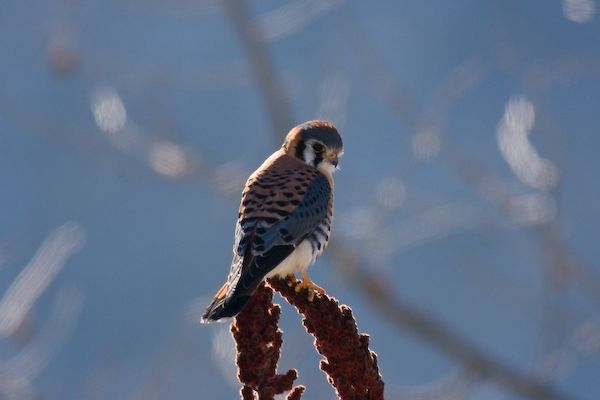
Since I missed the Allegheny Front Hawk Watch last weekend I’m itching to go out there today — but I can’t, I have to work. To compensate for this I spent time last evening looking through the hawk watch records at Hawkcount.org. The statistics are fascinating and they support a hunch I started to develop last year.
Every fall I attend two hawk watches 775 miles apart. In early September I visit the Cadillac Mountain Hawk Watch in Maine and see mostly American kestrels and sharp-shinned hawks, approximately one kestrel for every two sharpies. Then in October/November I visit the Allegheny Front where the most common hawks are sharp-shins and red-tails in nearly equal numbers. The kestrel count there is low, sometimes insignificant.
I used to think my experience at Cadillac Mountain was normal for September and that I missed seeing kestrels at The Front because I visited it too late in the fall. (That’s how I miss broad-winged hawk migration.) But I had a hunch I’d got it backwards. Perhaps, I thought, kestrels are scarce and my experience at Cadillac is unusual.
The numbers at Hawkcount.org bear that out. Compared to the number of sharp-shinned hawks, kestrels are 40-60% as numerous at Cadillac but are only 4-10% as numerous in Pennsylvania.
Kestrels really aren’t a big item at most hawk watches and my experience isn’t “normal.” I prefer to think of it as special. Special, like the kestrels themselves who are one of the most beautiful raptors on earth.
(photo of a male American Kestrel by Brian Herman)
So happy you are able to see a decent amount of American Kestrels at one of your locations. I find that we here in Central Massachusetts don’t get many most days. We actually went to Lighthouse Point in CT to see if we could get some falcons as they are my favorite raptors and we did get a decent amount of Kestrels, but not nearly as many as I would have like to have gotten.
Do try Acadia National Park in early September for kestrels. Don’t stay long though or you’ll miss broad-winged hawk migration. For some reason very few of them fly over Acadia.